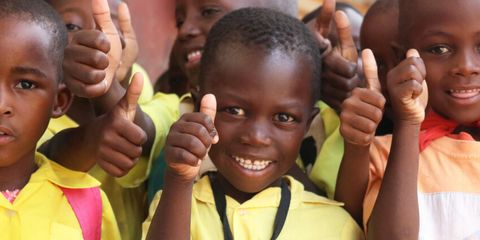Girls and young women bear the brunt of El Niño rains in Kenya
11 December 2023Devastating flooding caused by El Niño rains is placing girls and young women in Kenya at heightened risk of gender-based violence.
Torrential and widespread rains across Kenya have now forced nearly half a million people from their homes, according to the Interior Ministry, and killed 160 people. Across East Africa as a whole, more than 1 million people have been displaced.
In needs assessments conducted by Plan International in Tana River and Marsabit counties, girls and young women spoke of how they feel vulnerable after being forced to take shelter in schools and other public places, and how they fear being sexually assaulted and abused as a result of having to share rooms with multiple people.
The assessment teams also heard concerning reports that girls and young women have been asked for sexual favours in shelters but are often afraid to report abuse and harassment for fear of stigma and discrimination.
Plan International is working urgently to deliver humanitarian assistance to those affected by the El Niño rains, including supporting local authorities to identify children who are at risk of violence, abuse and exploitation and provide access to safe, child friendly spaces.
Girls and young women bear the brunt
George Otim, Country Director for Plan International Kenya, said: “As is all too often the case in emergencies, girls and young women are bearing the brunt as El Niño rains have devastated Kenya.
“Thousands of homes have been swept away, farmlands have been submerged and families have lost everything. We know from experience that in times of crisis, gender-based violence often increases when families and communities are left vulnerable.
“Plan International’s emergency response teams are working hard to deliver humanitarian assistance to children, especially girls, right now. But we also need to prevent these crises, which are made worse by our changing climate, from hitting so hard in the first place. We must improve early warning systems – it is imperative that families receive timely information, enabling them to make informed decisions, relocate to safer areas, and protect themselves during periods of heavy rainfall and floods.
“More funding is urgently required for both short-term relief efforts and long-term development to address the challenges faced by girls and young women.”
Girls share experiences of El Nino rains
In the words of Sofia, a mother from Tana River County, who endured a terrifying dash home from work to rescue her two children from their flooded home, “We struggled together until we reached the road. I tried to go back to salvage some belongings, but the water was up to my neck.”
Her daughter 9-year-old Mariah says she feels sad that her home has been destroyed. “All our things are gone. I was playing with my doll. The floods came and took my bag, doll, books and school uniform.”
This year’s El Niño rains come after East Africa’s worst drought in 40 years, which has left many communities in Kenya, particularly in arid and semi-arid parts of the country highly fragile.
“The floods came and took my bag, doll, books and school uniform.”
Mariah, 9.
Between October 2023 and January 2024, it is projected that 9% of the population (around 1.5 million people) in Mandera, Marsabit and Turkana counties, which were all affected by the floods, will experience crisis (IPC Phase 3) levels of food insecurity or higher
Plan International’s needs assessments also found that girls are finding it harder to manage their periods, with some being forced to use reusable shopping bags instead of sanitary towels after losing all their belongings during the rains.
There are further fears that flooding will contaminate water sources, increasing the risk of disease such as malaria, diarrhea and other water borne illnesses and making it extremely hard to find clean drinking water.
Plan International response aims to reach 17,500 people
As part of its emergency response, Plan International is providing water, sanitation and hygiene and cash assistance, with the aim of reaching 17,500 people.
Emergency response teams are also disseminating information to minimise risks from future flooding, with a focus on building resilience in the worst affected counties, including Marsabit, Turkana, Kwale, Tana River, Kilifi, Kisumu and Homabay.


